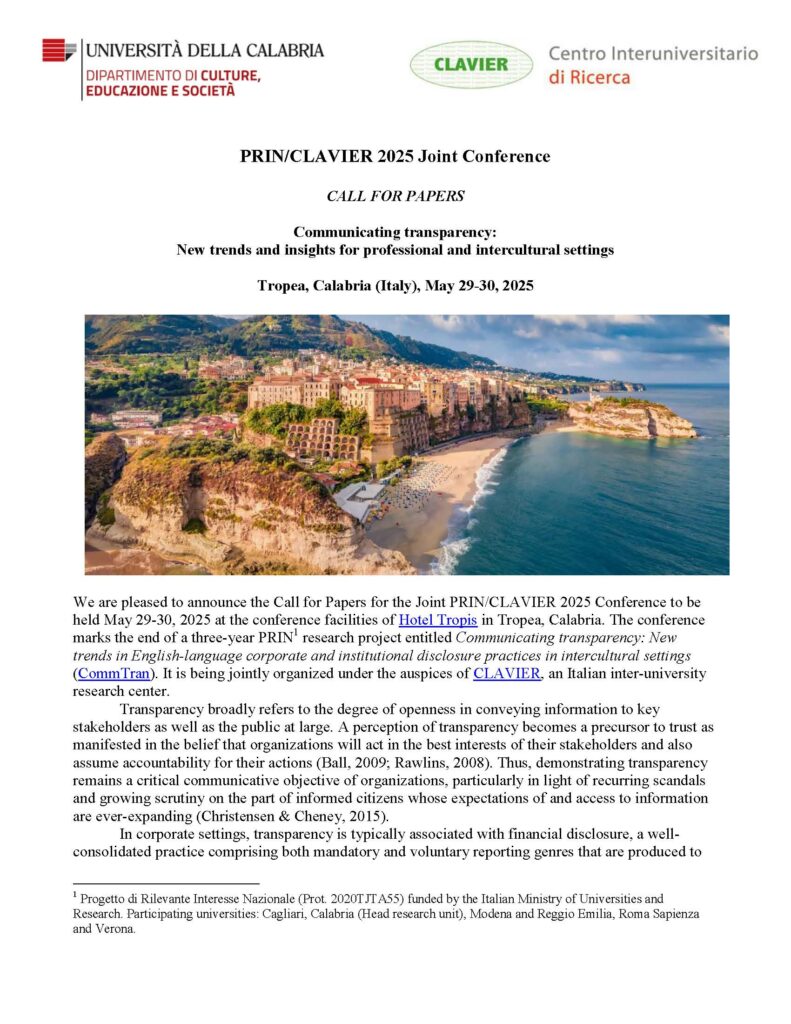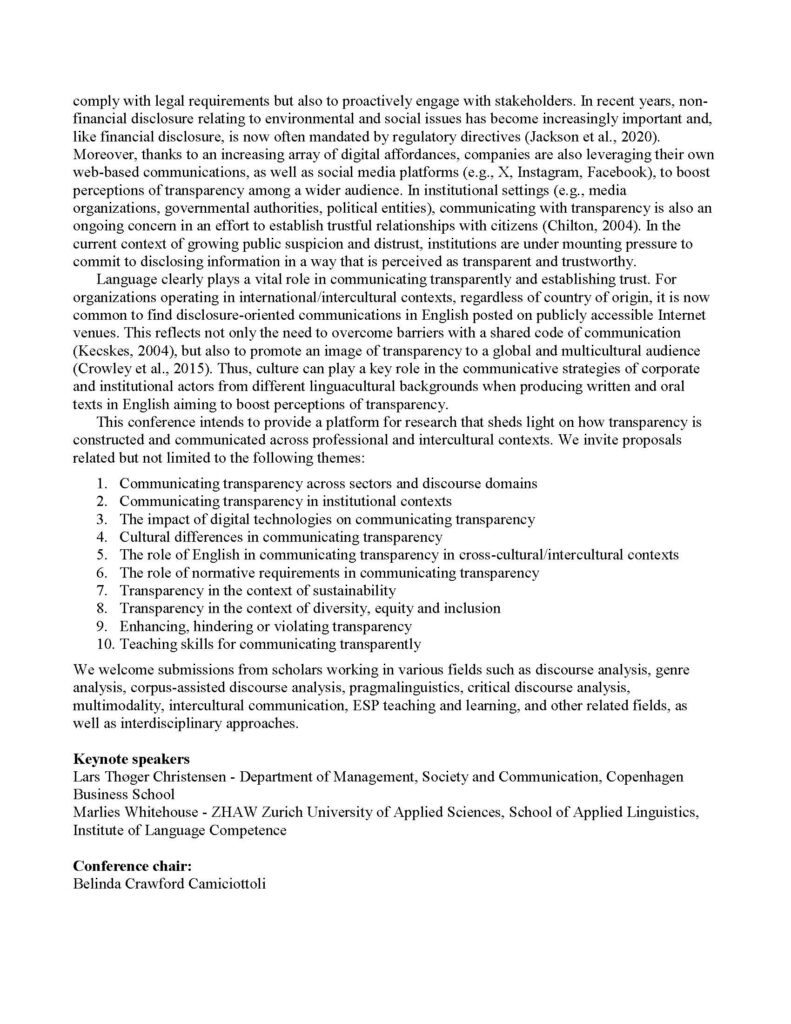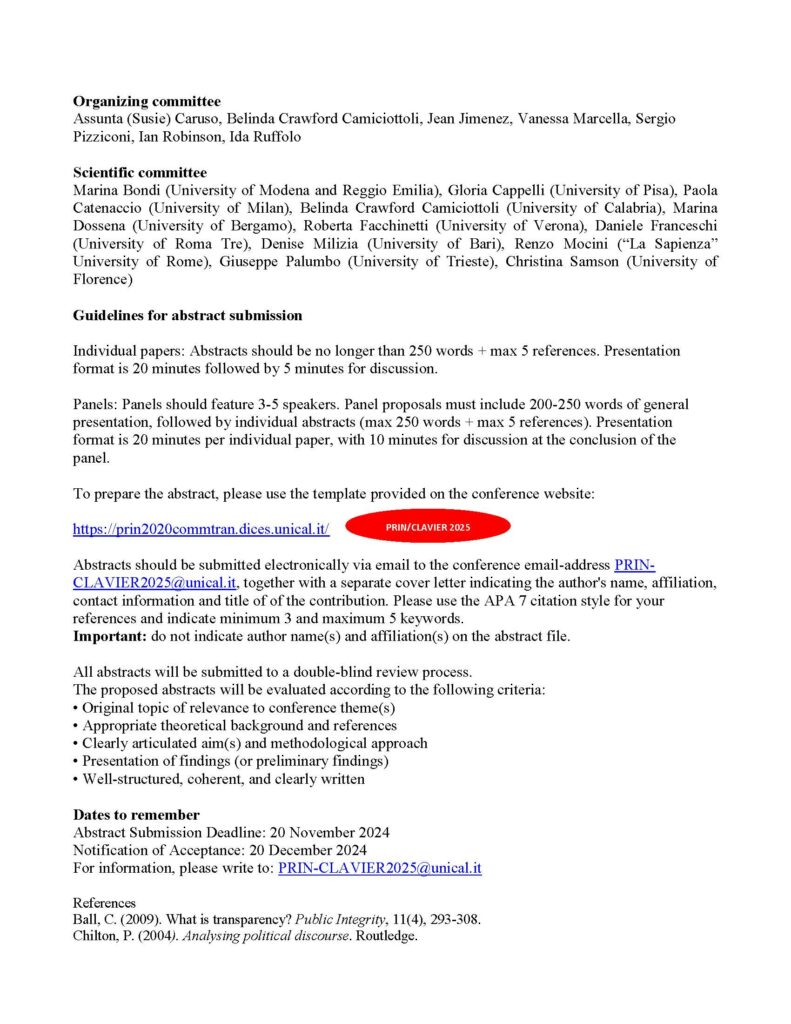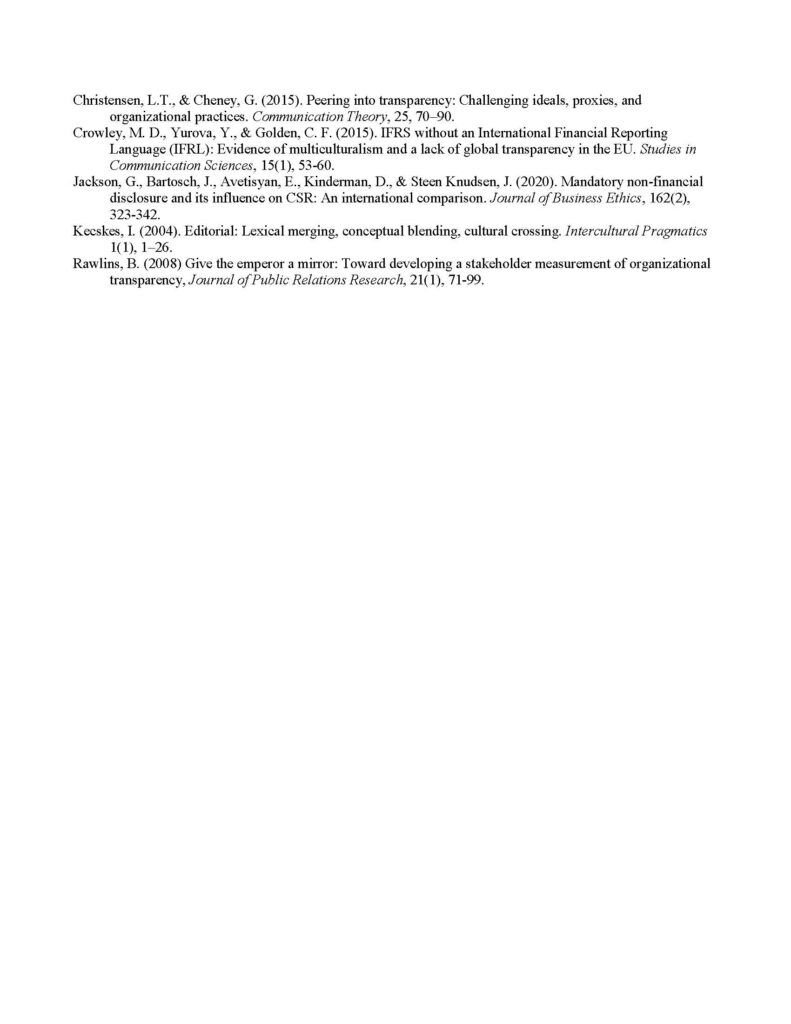PRIN/CLAVIER 2025 Joint Conference
CALL FOR PAPERS
Communicating transparency:
New trends and insights for professional and intercultural settings
Tropea, Calabria (Italy), May 29-30, 2025
We are pleased to announce the Call for Papers for the Joint PRIN/CLAVIER 2025 Conference to be held May 29-30, 2025 at the conference facilities of Hotel Tropis in Tropea, Calabria. The conference marks the end of a three-year PRIN1 research project entitled Communicating transparency: New trends in English-language corporate and institutional disclosure practices in intercultural settings (CommTran). It is being jointly organized under the auspices of CLAVIER, an Italian inter-university research center.
Transparency broadly refers to the degree of openness in conveying information to key stakeholders as well as the public at large. A perception of transparency becomes a precursor to trust as manifested in the belief that organizations will act in the best interests of their stakeholders and also assume accountability for their actions (Ball, 2009; Rawlins, 2008). Thus, demonstrating transparency remains a critical communicative objective of organizations, particularly in light of recurring scandals and growing scrutiny on the part of informed citizens whose expectations of and access to information are ever-expanding (Christensen & Cheney, 2015).
In corporate settings, transparency is typically associated with financial disclosure, a well-consolidated practice comprising both mandatory and voluntary reporting genres that are produced to comply with legal requirements but also to proactively engage with stakeholders. In recent years, non-financial disclosure relating to environmental and social issues has become increasingly important and, like financial disclosure, is now often mandated by regulatory directives (Jackson et al., 2020). Moreover, thanks to an increasing array of digital affordances, companies are also leveraging their own web-based communications, as well as social media platforms (e.g., X, Instagram, Facebook), to boost perceptions of transparency among a wider audience. In institutional settings (e.g., media organizations, governmental authorities, political entities), communicating with transparency is also an ongoing concern in an effort to establish trustful relationships with citizens (Chilton, 2004). In the current context of growing public suspicion and distrust, institutions are under mounting pressure to commit to disclosing information in a way that is perceived as transparent and trustworthy.
Language clearly plays a vital role in communicating transparently and establishing trust. For organizations operating in international/intercultural contexts, regardless of country of origin, it is now common to find disclosure-oriented communications in English posted on publicly accessible Internet venues. This reflects not only the need to overcome barriers with a shared code of communication (Kecskes, 2004), but also to promote an image of transparency to a global and multicultural audience (Crowley et al., 2015). Thus, culture can play a key role in the communicative strategies of corporate and institutional actors from different linguacultural backgrounds when producing written and oral texts in English aiming to boost perceptions of transparency.
This conference intends to provide a platform for research that sheds light on how transparency is constructed and communicated across professional and intercultural contexts. We invite proposals related but not limited to the following themes:
1. Communicating transparency across sectors and discourse domains
2. Communicating transparency in institutional contexts
3. The impact of digital technologies on communicating transparency
4. Cultural differences in communicating transparency
5. The role of English in communicating transparency in cross-cultural/intercultural contexts
6. The role of normative requirements in communicating transparency
7. Transparency in the context of sustainability
8. Transparency in the context of diversity, equity and inclusion
9. Enhancing, hindering or violating transparency
10. Teaching skills for communicating transparently
We welcome submissions from scholars working in various fields such as discourse analysis, genre analysis, corpus-assisted discourse analysis, pragmalinguistics, critical discourse analysis, multimodality, intercultural communication, ESP teaching and learning, and other related fields, as well as interdisciplinary approaches.
Keynote speakers
Lars Thøger Christensen – Department of Management, Society and Communication, Copenhagen Business School
Marlies Whitehouse – ZHAW Zurich University of Applied Sciences, School of Applied Linguistics, Institute of Language Competence
Conference chair:
Belinda Crawford Camiciottoli
Organizing committee
Assunta (Susie) Caruso, Belinda Crawford Camiciottoli, Jean Jimenez, Vanessa Marcella, Sergio Pizziconi, Ian Robinson, Ida Ruffolo
Scientific committee
Marina Bondi (University of Modena and Reggio Emilia), Gloria Cappelli (University of Pisa), Paola Catenaccio (University of Milan), Belinda Crawford Camiciottoli (University of Calabria), Marina Dossena (University of Bergamo), Roberta Facchinetti (University of Verona), Daniele Franceschi (University of Roma Tre), Denise Milizia (University of Bari), Renzo Mocini (“La Sapienza” University of Rome), Giuseppe Palumbo (University of Trieste), Christina Samson (University of Florence)
Guidelines for abstract submission
Individual papers: Abstracts should be no longer than 250 words + max 5 references. Presentation format is 20 minutes followed by 5 minutes for discussion.
Panels: Panels should feature 3-5 speakers. Panel proposals must include 200-250 words of general presentation, followed by individual abstracts (max 250 words + max 5 references). Presentation format is 20 minutes per individual paper, with 10 minutes for discussion at the conclusion of the panel.
To prepare the abstract, please use the template provided on the conference website:
https://prin2020commtran.dices.unical.it/
Abstracts should be submitted electronically via email to the conference email-address PRIN-CLAVIER2025@unical.it, together with a separate cover letter indicating the author’s name, affiliation, contact information and title of of the contribution. Please use the APA 7 citation style for your references and indicate minimum 3 and maximum 5 keywords.
Important: do not indicate author name(s) and affiliation(s) on the abstract file.
All abstracts will be submitted to a double-blind review process.
The proposed abstracts will be evaluated according to the following criteria:
• Original topic of relevance to conference theme(s)
• Appropriate theoretical background and references
• Clearly articulated aim(s) and methodological approach
• Presentation of findings (or preliminary findings)
• Well-structured, coherent, and clearly written
Dates to remember
Abstract Submission Deadline: 20 November 2024
Notification of Acceptance: 20 December 2024
For information, please write to: PRIN-CLAVIER2025@unical.it
References
Ball, C. (2009). What is transparency? Public Integrity, 11(4), 293-308.
Chilton, P. (2004). Analysing political discourse. Routledge.
Christensen, L.T., & Cheney, G. (2015). Peering into transparency: Challenging ideals, proxies, and organizational practices. Communication Theory, 25, 70–90.
Crowley, M. D., Yurova, Y., & Golden, C. F. (2015). IFRS without an International Financial Reporting Language (IFRL): Evidence of multiculturalism and a lack of global transparency in the EU. Studies in Communication Sciences, 15(1), 53-60.
Jackson, G., Bartosch, J., Avetisyan, E., Kinderman, D., & Steen Knudsen, J. (2020). Mandatory non-financial disclosure and its influence on CSR: An international comparison. Journal of Business Ethics, 162(2), 323-342.
Kecskes, I. (2004). Editorial: Lexical merging, conceptual blending, cultural crossing. Intercultural Pragmatics 1(1), 1–26.
Rawlins, B. (2008) Give the emperor a mirror: Toward developing a stakeholder measurement of organizational transparency, Journal of Public Relations Research, 21(1), 71-99.




